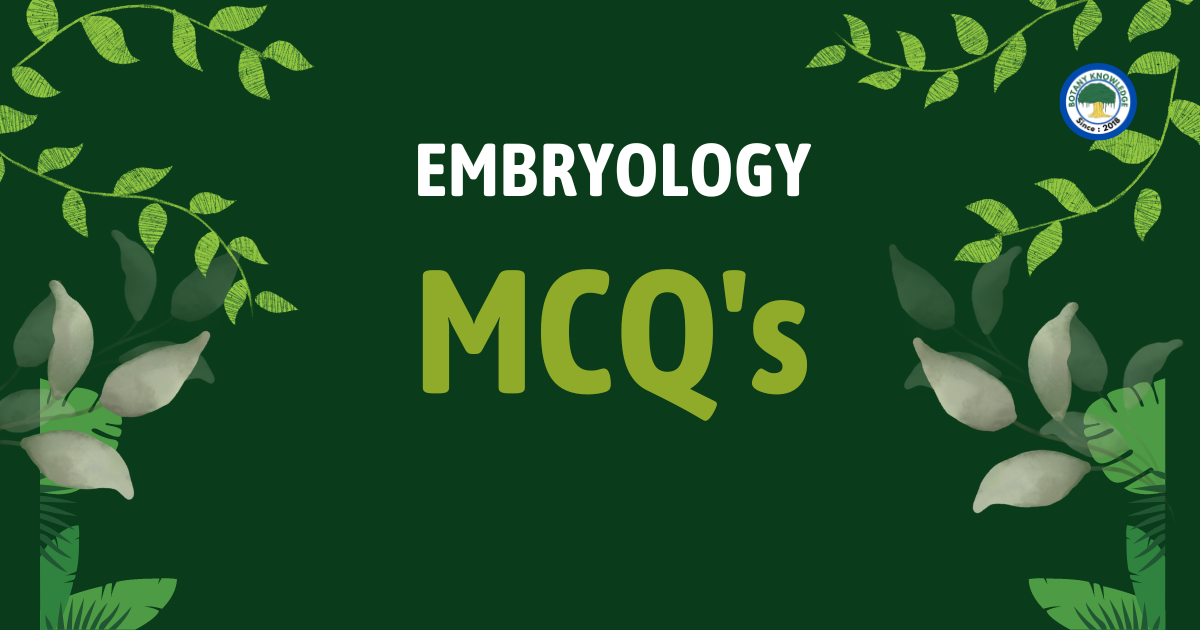Most Important Embryology MCQ's
1. Bisexual flowers
2. Anther
3. Stamens
4. Unisexual flowers
Answer : 1. Bisexual flowers
2. The transfer of pollen from the anther to stigma is called
1. Pollination
2. Fertilization
3. Adoption
4. Diffusion
Answer : 1. Pollination
3. The fusion of female reproductive nucleus with the male reproductive nucleus is known as
1. Adoption
2. Excretion
3. Fertilization
4. Regeneration
Answer : 3. Fertilization
4. The two nuclei at the end of the pollen tube are called
1. Tube nucleus and a generative nucleus
2. Sperm and ovum
3. Generative nucleus and stigma
4. Tube nucleus and sperm
Answer : 1. Tube nucleus and a generative nucleus
5. Generative nucleus divides forming
1. 2 male nuclei
2. 3 male nuclei
3. 2 female nuclei
4. 3 female nuclei
Answer : 1. 2 male nuclei
6. Embryo sac is located inside the
1. Stigma
2. Ovule
3. Micropyle
4. Style
Answer : 2. Ovule
7. One nucleus of the pollen tube and secondary nucleus of the ovum grow into
1. Stigma
2. Endosperm
3. Anther
4. Stamen
Answer : 2. Endosperm
8. The male reproductive parts of a flower, the stamens, are collectively known as
1. Androecium
2. Filament
3. Anther
4. Gynoecium
Answer : 1. Androecium
9. The other name for gynoecium is
1. Pistil
2. Stigma
3. Androecium
4. Style
Answer : 1. Pistil
10. Functional megaspore in a flowering plant develops into
1. Endosperm
2. Ovule
3. Embryo-sac
4. Embryo
Answer : 3. Embryo-sac
11. Which of the following is similar to autogamy, but requires pollinators?
1. Geitonogamy
2. Cleistogamy
3. Apogamy
4. Xenogamy
Answer : 1. Geitonogamy
12. What is the function of the filiform apparatus?
1. Guide the entry of pollen tube
2. Recognize the suitable pollen at the stigma
3. Produce nectar
4. Stimulate division of the generative cell
Answer : 1. Guide the entry of pollen tube
13. A mass of nutritive material outside the embryo sac is called _____
1. Protoplasm
2. Pericarp
3. Ectoderm
4. Perisperm
Answer : 4. Perisperm
14. Which of the following statements is correct?
1. Sporogenous tissue is haploid
2. The hard outer layer of pollen is called intine
3. Tapetum nourishes the developing pollen
4. Microspores are produced by endothecium
Answer : 3. Tapetum nourishes the developing pollen
15. Which of the following fruit is produced by parthenocarpy?
1. Brinjal
2. Apple
3. Banana
4. Jackfruit
Answer : 3. Banana
16. The process of formation of seeds without fertilization in flowering plants is known as
1. Budding
2. Apomixis
3. Sporulation
4. Somatic hybridization
Answer : 2. Apomixis
17. Functional megaspore in an angiosperm develops into
1. Endosperm
2. Embryo
3. Embryo-sac
4. Ovule
Answer : 3. Embryo-sac
18. Rewards and attractants are required for
1. Entomophily
2. Cleistogamy
3. Anemophily
4. Hydrophily
Answer : 1. Entomophily
19. A dioecious flowering plant prevents
1. Geitonogamy and xenogamy
2. Autogamy and xenogamy
3. Autogamy and geitonogamy
4. Cleistogamy and xenogamy
Answer : 3. Autogamy and geitonogamy
20. Parthenogenesis is
(a) development of embryo without fertilization
(b) development of fruit without fertilization
(c) development of fruit without hormones
(d) development of embryo from egg without fertilization.
Answer : (b) development of fruit without fertilization
21. Male gametophyte of angiosperms is shed as
(a) four celled pollen grain
(b) three celled pollen grain
(c) microspore mother cell
(d) anther.
Answer : (b) three celled pollen grain
22. Total number of meiotic division required for forming 100 zygotes/100 grains of wheat is
(a) 100
(b) 75
(c) 125
(d) 50.
Answer : (c) 125
23. Perisperm is
(a) remnant of endosperm
(b) persistent nuccllus
(c) peripheral part of endosperm
(d) disintegrated secondary nucleus.
Answer : (b) persistent nuccllus
24. Development of an organism from female gamete/’ egg without involving fertilization is
(a) adventitive embryony
(b) polyembryony
(c) parthenocarpy
(d) parthenogenesis.
Answer : (d) parthenogenesis.
25. Generative cell was destroyed by laser but a normal pollen tube was still formed because
(a) vegetative cell is not damaged.
(b) contents of killed generative cell stimulate pollen growth
(c) laser beam stimulates growth of pollen tube
(d) the region of emergence of pollen tube is not harmed.
Answer : (a) vegetative cell is not damaged.
26. Male gametophyte of angiosperms/monocots is
(a) microsporangium
(b) nucellus
(c) microspore
(d) stamen.
Answer : (c) microspore
27. Female gametophyte of angiosperms is represented by
(a) ovule
(b) megaspore mother cell
(c) embryo sac
(d) nucellus.
Answer : (c) embryo sac
28. Entry of pollen tube through micropyle is
(a) chalazogamy
(b) mesogamy
(c) porogamy
(d) pseudogamy
Answer : (c) porogamy
29. Pollination occurs in
(a) bryophytes and angiosperms
(b) pteridophytes and angiosperms
(c) angiosperms and gymnosperms
(d) angiosperms and fungi.
Answer : (c) angiosperms and gymnosperms
30. Embryo sac occurs in
(a) embryo
(b) axis part of embryo
(c) ovule
(d) endosperm.
Answer : (c) ovule


